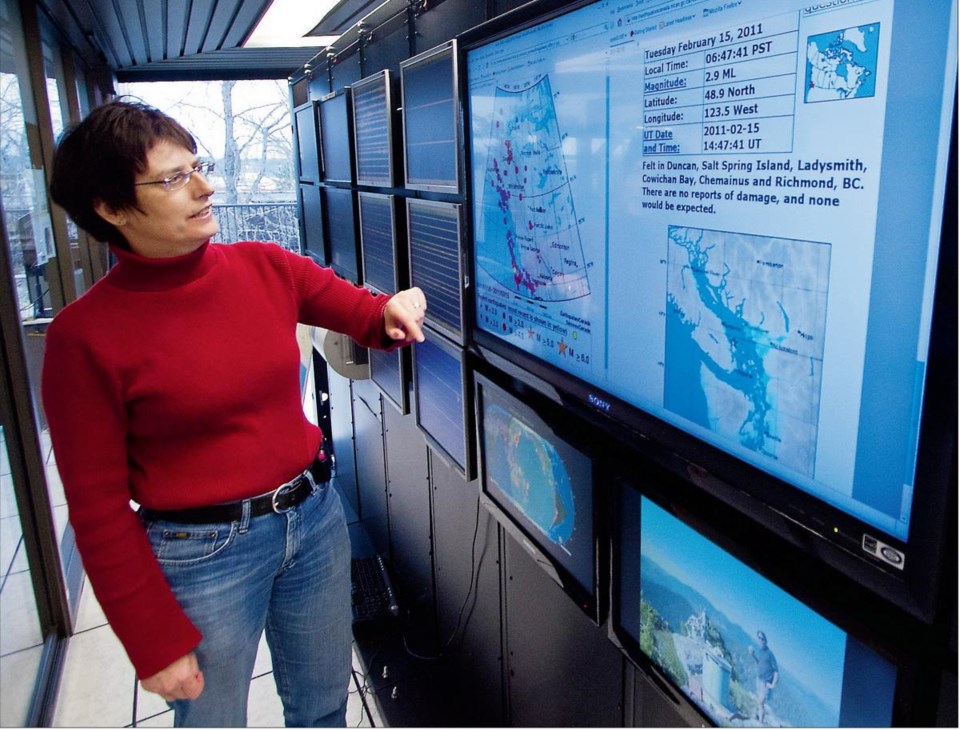Look no further than Japan to see the earthquake that will - not might - hit Vancouver Island, local earthquake experts say.
Japan's devastating 9.0-magnitude earthquake was caused by a megathrust subduction earthquake, caused when one of the Earth's plates, that is beneath another plate, slips.
The same situation is happening here, with the Juan de Fuca plate underneath the North America plate.
That plate will slip, said earthquake seismologist Taimi Mulder of the Pacific Geoscience Centre in North Saanich, although just when it will happen isn't known.
"The situation there [in Japan] is very analogous to the situation here," Mulder said.
The only positive out of the devastation is that Japan has very advanced equipment that will have fully tracked the earthquake.
Scientists will be able to analyze that data and apply it elsewhere.
"We've never ever, ever had an area so close to an earthquake this big and had this much data that will be coming out of it," Mulder said.
"It's exciting but scary, because it really hits home what an earthquake of this magnitude means."
Japan has seismic instruments at many sites throughout the country, and scientists will sift through that trove of information.
"We'll be able to compare it to our situation here and look at the similarities and the differences and answer the question: what do we need to address? The lessons that will be learned on so many different fronts can all be applied here," Mulder said.
"Are our assumptions about the strength of the shaking valid? Does our building code address that? Do we need to change the building code? Have we overdesigned in some places? Maybe the shaking won't go as far inland as we thought or maybe it will go further.
These are the types of things relevant to public safety that will come out of this."
Earthquakes happen because the earth's crust is composed of plates, formed when the earth cooled and cracked. But these plates, all varying in size, are slowly shifting, some at about the rate a fingernail grows. Over time, these tiny shifts mean the pieces rub up against each other, and create pressure. Sometimes one may subduct -go underneath -the other.
When the plates meet and move against each other, stress builds up. When the stress becomes too great, a sudden rupture occurs along a fault, or zone of weakness in the crust, causing an earthquake.
There's an added earthquake risk on the West Coast though. Here, we have the Cascadia subduction zone, created by the meeting of the enormous and thicker North American plate and the thinner, smaller Juan de Fuca plate.
When this happens, the smaller plate slides underneath the more dominant plate, creating a subduction zone. The Cascadia zone runs about 1,000 kilometres, from 70 kilometres off Nootka Island, off the northwest coast of Vancouver Island, to the California-Oregon border.
That zone is now locked, which means it is accumulating stress. That stress is what causes earthquakes. When the plate "unlocks," that's when there is a megathrust earthquake, as recently happened in Japan -and what happened in Indonesia in 2004.
Such earthquakes happen anywhere between 200 and 1,000 years apart, registering a magnitude 8 or more, and can cause large tsunamis.
But there's no accurate way to tell just when that unlocking would happen.
Other smaller earthquakes occur within either the North American plate or the Juan de Fuca plate. These are generally smaller in magnitude but closer to the surface, so can cause much damage.
North American plate earthquakes often have aftershocks. Such an earthquake caused much damage in central Vancouver Island on June 23, 1946, when a 7.3-magnitude quake destroyed buildings and toppled chimneys in Courtenay. It was felt in Victoria, Vancouver and as far east as the Rocky Mountains.
Juan de Fuca plate quakes take place in the descending smaller plate, about 40 to 60 kilometres below the surface, in a swath from the northern Gulf Islands to Puget Sound.
They are the most frequent type of earthquake in the region. One came in at magnitude 6.8 in 2001. While it largely shook Seattle and the Puget Sound area, it was felt in Victoria and Vancouver, and caused $2 billion damage.
kwestad@timescolonist.com



